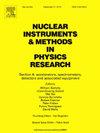用于在 LEAF 平台上研究核材料协同损伤的可变能量鸡尾酒束技术
IF 1.5
3区 物理与天体物理
Q3 INSTRUMENTS & INSTRUMENTATION
Nuclear Instruments & Methods in Physics Research Section A-accelerators Spectrometers Detectors and Associated Equipment
Pub Date : 2024-10-15
DOI:10.1016/j.nima.2024.169987
引用次数: 0
摘要
本研究探讨了聚变反应堆结构材料中的协同辐射损伤这一关键问题,重点是位移缺陷与嬗变产生的氢和氦之间的相互作用。我们利用 LEAF(低能量高强度高电荷离子加速器设施)平台先进的多束离子注入能力模拟和研究了这些效应。首先,成功生成了高强度鸡尾酒束,如 "4He+ 和 56Fe14+"以及 "4He+ 和 58Ni15+"。然后,通过可变能量辐照模拟聚变反应堆内的复杂辐射环境。其次,通过 LEAF 平台的创新能量调制系统精确控制鸡尾酒束的能量,获得不同离子的相似穿透深度,这对研究协同效应至关重要。最后,利用透射电子显微镜(TEM)和纳米压痕技术进行的辐照后分析揭示了明显的微观结构变化和材料性能改变,为了解辐照下的降解机制提供了线索。这项工作不仅能产生多种高强度的 "鸡尾酒 "离子束,还能实现离子束的快速能量切换。此外,这项工作有望为在先进重离子直线加速器中实施新型多束辐照技术铺平道路,并为研究核材料的协同效应提供创新的实验方法和技术支持。本文章由计算机程序翻译,如有差异,请以英文原文为准。
Variable-energy cocktail beam technology for investigating synergistic damage in nuclear materials on LEAF platform
This study addresses the critical issue of synergistic radiation damage in structural materials of fusion reactors, focusing on the interaction between the displacement defects and transmutation-produced hydrogen and helium. These effects are simulated and investigated by employing the advanced multi-beam ion implantation capabilities of the LEAF (Low Energy high intensity highly charged ion Accelerator Facility) platform. Firstly, high-intensity cocktail beams, such as “4He+ and 56Fe14+" and “4He+ and 58Ni15+", are generated and characterized successfully. Then, a complex radiation environment is mimicked within the fusion reactors by applying variable-energy irradiation. Secondly, similar penetration depths for different ions, which are crucial for studying synergistic effects, are obtained by precisely controlling the energy of the cocktail beams through the innovative energy modulation system of the LEAF platform. Finally, the post-irradiation analyses, performed by using the transmission electron microscopy (TEM) and nanoindentation, revealed distinct microstructural changes and alterations in material properties, providing insights into the degradation mechanisms under irradiation. This work not only generates diverse and high-intensity “cocktail” ion beams but also achieves rapid energy switching of the beams. Further, the work is expected to pave the way for the implementation of a novel multi-beam irradiation technique in advanced heavy-ion linear accelerators, and also to provide innovative experimental methods and technical support for studying the synergistic effects of nuclear materials.
求助全文
通过发布文献求助,成功后即可免费获取论文全文。
去求助
来源期刊
CiteScore
3.20
自引率
21.40%
发文量
787
审稿时长
1 months
期刊介绍:
Section A of Nuclear Instruments and Methods in Physics Research publishes papers on design, manufacturing and performance of scientific instruments with an emphasis on large scale facilities. This includes the development of particle accelerators, ion sources, beam transport systems and target arrangements as well as the use of secondary phenomena such as synchrotron radiation and free electron lasers. It also includes all types of instrumentation for the detection and spectrometry of radiations from high energy processes and nuclear decays, as well as instrumentation for experiments at nuclear reactors. Specialized electronics for nuclear and other types of spectrometry as well as computerization of measurements and control systems in this area also find their place in the A section.
Theoretical as well as experimental papers are accepted.

 求助内容:
求助内容: 应助结果提醒方式:
应助结果提醒方式:


